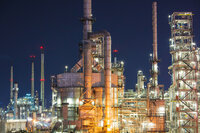
In this guide, we’ll explain what explosion-proof lighting is, where it’s used, and why it’s critical for safety in high-risk industries.
What Is Explosion-Proof Lighting?
Explosion-proof lighting, sometimes referred to as hazardous area lighting or ATEX lighting (in Europe), is designed to contain any sparks or heat that could ignite flammable substances in the surrounding atmosphere. Contrary to the name, these fixtures do not prevent explosions in the environment — rather, they prevent the lighting itself from becoming the source of ignition.Certified explosion-proof fixtures are constructed with durable materials and sealed enclosures that can withstand internal explosions and prevent flames or hot gases from escaping into the surrounding area.
Why Is Explosion-Proof Lighting So Important?
Explosion-proof lighting is not just a precaution — it is often a legal requirement in many industries and hazardous zones. Here’s why it’s crucial:- Prevents Ignition in Hazardous Areas: In locations like oil refineries, chemical plants, and grain storage facilities, explosive atmospheres can form. Explosion-proof lighting ensures that no internal fault or heat source can ignite these substances.
- Protects Workers and Infrastructure: By reducing the risk of explosions, these lighting systems protect employees, equipment, and buildings from potentially devastating incidents.
- Meets Safety Regulations: Using certified explosion-proof lighting helps companies comply with safety standards such as the ATEX directive in Europe or NEC/IECEx in other regions.
- Minimizes Downtime and Costs: Explosions not only cause harm but also lead to costly downtime, repairs, and legal penalties. Explosion-proof lighting minimizes these risks.
Where Is Explosion-Proof Lighting Used?
Explosion-proof lighting is required in facilities classified as hazardous locations. Common environments include:- Oil and Gas Facilities
- Chemical Manufacturing Plants
- Mining Sites
- Pharmaceutical Production
- Food and Grain Processing
- Paint Shops
- Waste Treatment Plants
Types of Explosion-Proof Lighting
Several types of explosion-proof fixtures are available, including:- Floodlights: For illuminating large outdoor or indoor areas.
- Linear Lights: Ideal for production lines and assembly areas.
- Portable and Handheld Lamps: Used for inspections and maintenance in hazardous zones.
- Emergency and Exit Lighting: Critical for safe evacuation during incidents.
Benefits of LED Explosion-Proof Lighting
Modern explosion-proof lighting often uses LED technology for even greater safety and efficiency. Benefits include:- ✅ Lower energy consumption
- ✅ Longer lifespan and reduced maintenance
- ✅ Improved light output and visibility
- ✅ Less heat generation, lowering ignition risk
What to Consider When Purchasing Explosion-Proof Lighting?
Choosing the right lighting for hazardous areas requires careful attention. Key factors include:- The ATEX zone where the light will be installed (Zone 1, Zone 2, etc.)
- Protection method (e.g., Ex d flameproof, Ex e increased safety, Ex n restricted breathing)
- Temperature class to ensure the fixture stays below ignition temperatures
- Official certifications such as ATEX and IECEx for compliance and safety assurance